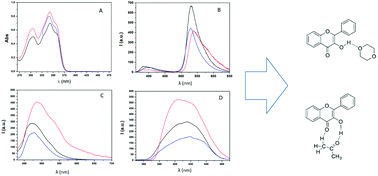Role of solute-solvent hydrogen bonds on the ground state and the excited state proton transfer in 3-hydroxyflavone. A systematic spectrophotometric study†
Abstract
A detailed account on the photophysics of 3-hydroxyflavone (3HF) in 27 organic solvents is reported. Dual fluorescence of neutral 3HF was observed in protic, polar, and weakly polar solvents, endowed with sufficiently high hydrogen bond accepting and/or donating capabilities. Ground-state solvent-induced 3HF deprotonation was reported in 14 cases. 3HF anion photophysics was investigated, and the deprotonation constant Kdep calculated. Previously reported models (based on solute-solvent intermolecular hydrogen bonds) to explain solvent effects on Excited-State Intramolecular Proton Transfer (ESIPT) and on solvent-induced deprotonation have been re-examined and improved in order to rationalize the observed photophysical behaviour in all the studied solvents. Hydrogen bond donor acidity and hydrogen bond acceptor basicity are shown to be key parameters. The results are discussed in the framework of the use of 3HF as an environment-sensitive fluorescent sensor in several research fields, and as a model system in the study of ESIPT reactions. Solvent effects on 3HF reactivity are also discussed, as the role of the surrounding media on the chemistry of flavonols is an emerging topic in natural product research.

- This article is part of the themed collection: 28th International Conference on Photochemistry (ICP 2017)


 Please wait while we load your content...
Please wait while we load your content...